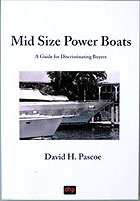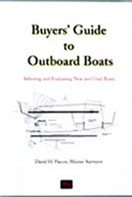Small Boat Safety at Sea
Boat Safety at Sea - Part I
Outboard Boats
by David Pascoe
Intermediate Size Sport Fishermen and Cruisers
Why do so many small boats founder in the ocean? We take a look at this problem and provide some answers on how to avoid becoming a statistic.
In recent weeks the Miami television evening news has been filled with numerous stories of small boat disasters out in the Gulf Stream. A number of them have had video clips taken from a Coast Guard rescue helicopter that shows a 24 foot boat floating upside down with a couple of people trying to hang onto the bottom.
The story line tersely states that the people were rescued (in one case a man drowned) after their boat "capsized." Experience boaters might blanch at that word since capsize means to tip over. The video clip shows something like two to three foot waves. So how did the boat capsize? Well, obviously it didn't; the right word would probably be "foundered" meaning to fill up with water, at which point it rolls over.
One of the more notable things about those video clips is that the men hanging onto the overturned boats didn't have life jackets on. Were they out there without them, or did the boats go down so fast that they couldn't get the LJ's out of wherever they were tucked away fast enough. We don't know, but there they were, bobbing around in the water 10 miles off the coast without them.
Altogether, I'd guess that if I watched the evening news every day for a year, I'd probably see several dozen such stories annually. If I multiply this by the number of major boating centers around the nation, that works out to hundreds of such founderings occurring every year. And that means that this is an all too frequent occurrence, so I'll try to give you some insight as to why this happens and what you can do to avoid making the evening news.
Almost every day I'm out on the ocean doing sea trials and I see people out there fishing in all kinds of weather conditions. And as one who has traveled far and wide in small boats, I don't find that being out there in moderately rough water is particularly dangerous, albeit with two important caveats. First is that the operator is experienced in small boat handling, and second that he is knowledgeable and meticulous about the maintenance of his vessel.
I'd also say that it is not wise to venture far out in the ocean in a small boat unless you are a highly experienced and skilled seaman. Particularly in single engine outboard boats. Those who have a lot of sea experience are believers in O'Tools Law. Mr. O'Tool, you see, theorizes that Mr. Murphy is overly optimistic.
Out on the ocean is a place where things can really go wrong fast. And most of us salty types are firm believers in the adage that problems come in threes. Boaters get in serious trouble as a result of the natural cause and effect relationship that sets off chain reactions of problems. One little thing happens that leads to a bigger thing and yet another. Unless you've had the experience, it's hard to understand how fast problems can snowball. Unless you know how one little loose wire can translate into a helicopter rescue at sea (if your lucky), then you'll never really appreciate the danger you're putting yourself in when you head out into the ocean in a small boat.
Another notable aspect of the helicopter video views I saw was that the ocean seemed like it was a really nice day out there. So why did these boats founder? The answer is that there are a lot of reasons why you could end up swimming next to your upside down boat. The most obvious one is that water was coming into the boat faster than the operator's ability to remove it. This usually translates to poor boat handling skills, inadequate bilge pumping capacity or both. But before I get into that, let's talk about small boats a bit first.
The problem with small boats is that they are small. That's a no-brainer, right? But do you know why? Have you thought about how the smallness of the boat means that it can fill up with water very fast? Generally speaking, small boats such as outboards are far less sea worthy than larger boats because:
- The transoms are either wide open or cut down.
- The cockpits are wide open, the freeboards are lower.
- They have smaller and fewer bilge pumps, often only one.
- They have smaller and fewer batteries.
- Cockpit decks are not water tight.
- Control cables have holes in liners that allow a lot of water entry.
- Outboards have all the engine weight at the stern, making them stern heavy.
As you can see, I've just listed seven major reasons why smaller boats are more vulnerable than larger boats. But one of the most important reasons has to do with wave size relative to boat size. The most common conditions found along our Atlantic coastline in the summer is a two foot chop. Yet the average 22-24' boat is vulnerable to this size wave by virtue of its size. The two foot wave that is no threat to a 30 foot inboard boat, can be a serious threat to an outboard under certain conditions.
It would be one thing if that outboard boat had an absolutely water tight cockpit liner, but as you well know, almost none of them do. There are holes and leaky access ports all over the place. Even that wouldn't be so much of a risk if the boat had several large bilge pumps and big batteries to run them. Yet most often we find a single bilge pump in the stern powered by one or two car batteries just large enough to start the engine.
Were I a lawyer, I could make a hell of a good legal argument that boats that meet this description are not seaworthy to be out in the ocean. But hundreds of them are out there every day and only a handful of them meet with calamity. So why don't more of them founder? Mainly due to dumb luck. It takes the right circumstances at the right time to create the disaster. Like that loose bilge pump wire I mentioned earlier.
One of those circumstances is when the fisherman stops and puts his stern to the waves. Water is sloshing over the transom and what he is not realizing is that the bilge is slowly filling up with water through all those holes and leaks. It doesn't take much water in the bilge before the hull looses enough buoyancy that one bigger wave comes over the transom and fills up the cockpit. At this point, the sheer weight of the water has turned moderate leakage into the hull into cascades of water. The hull is now even lower in the water and the next wave is the coup de gras.
Ah, you say, but the bilge pump is taking care of all that. Is it? How do you know, did you check? If you're like most people, it never even crossed your mind to check.
How to Improve Seaworthiness
From the foregoing, it should be obvious what to do. Seal up all possible points of water entry into the hull, including those plastic inspection ports. Remember, they're plastic, not steel. Put some weight on the covers or load up the deck and both the covers and frames will easily bend. That's where the serious leaks come from. I'd suggest installing the lids with silicone sealer. That will at least cut down on the amount of leakage.
Most boats are sold with grossly inadequate bilge pumping and battery capacity. You can have big pumps but that is no help if they're running off puny batteries, particularly when they're old. That's a prescription for disaster.
When thinking about what is enough pump capacity, take that GPH (gallon per hour) number and break it down into minutes. A 1500 GPH pump is only 25 GPM. Remember that you don't have an hour to wait for a pump to remove 1500 gallons of water; when in trouble, you got to get that water out fast, so we're talking a matter of minutes here, not an hour. Moreover, when you look at the pump flow, is it really putting out 25 GPM, or is it something less? Keep in mind that the manufacturer rating is obtained under ideal conditions and that actual performance is going to be quite a bit less.
The Universal Cosmic Law
One pump is NEVER enough because of the propensity for pump failure. You should just assume that one pump is going to fail when you need it most.
To figure what your pumping requirements are, calculate the cubic volume of the after half of the hull. Why half? That's because all the water tends to concentrate aft. Find the mid point of the hull and measure the length, width and depth from deck to keel. That will give you a cubic on which to base your capacity requirement. A 22 foot boat would give you something like 176 cubic feet (11 x 8 x 2). There are 7.5 gallons per cubic foot so we get 1320 gallons. Naturally, fuel tanks and other things are taking up space in the bilge and we don't account for these to leave a margin of safety. The bottom is also a vee but we calculated for a rectangle instead of our actual triangular hull, but we ignore that too.
So, how fast do you want to get that 1320 gallons out of your hull. You can see my point here that our single Rule 1500 is going to take about an hour because 1320 is about what it will really pump. Unfortunately, when calamity strikes, you don't have an hour. Personally, I'd like to get that time down to just a few minutes. If I increase my pumping to a pair of Rule 3000 pumps (50 gpm each), the dewatering rate decreases to 13 minutes, and with the large safety margin I built in on the hull volume, the actual number is probably closer to 6 minutes since our hull doesn't really hold 1320 gallons, but about half that.
Whew! Boy, I feel a lot better those kind of numbers.
Now let's talk about what powers the pumps, the batteries. The standard automotive battery, which most boats have with the main difference the word "marine" stenciled on them, is a 60 ampere hour battery. Theoretically, it will give you up to 60 amperes for one hour, or 10 amps for six hours. In reality, battery capacity decreases dramatically with age, and since this is always declining, the way I figure it is to use half the rating as what I can reasonably expect at any given time. So, we look at the pump rating, say it's 7.5 amps. If my reasonable estimate of battery power is 30 ampere hours, I don't have much of a power cushion there to rely upon in a pinch. I could be thinking that's no problem because I've got an engine alternator that is always feeding it more power. That's a mistaken assumption when the engine quits. Glub.
Boat builders usually provide the minimum amount of battery power necessary with no safety margin. My own view is that a 60 AH battery is way too small for even a small boat. Battery power is directly related to plate size. That's why we can't escape from battery size, which is a problem in small boats. You want lots of battery power, but there ain't no place to put larger ones. Somehow, someway, you need larger batteries when you propose to go offshore.
If I've got two 7.5 amp bilge pumps, that's 15 amps per hour, which can bring down a battery in a hurry. Therefore, what I'd like to have is a pair of 90 AH batteries which I figure at half the rating or 45 AH each. (A 90 Ah battery is roughly 1.5 times the size of a 60.) Now I'm looking at 90 amps of deliverable power (assuming they're wired in parallel) divided by 15 theoretically gives me 6 hours of pumping time with a very comfortable margin. That makes me feel a lot better, too.
A Few Other Points
Of course, large waves crashing over the transom and filling up the cockpit could still cause the boat to become unstable and roll over, so we make it a point to never stop with our stern to the seas. Bear in mind that with outboards and stern drives all the weight is in the stern and for this reason the boat can founder very quickly without a lot of water in it since all that water also runs to the stern. It goes down stern-first and then rolls over due to the engine weight. If you're going to drift fish and the stern tends to swing around upwind (as many boats do) you need to get yourself a sea anchor that will keep the bow into the waves.
(A sea anchor is simply a stout canvass bag with a bridle attached. It creates drag so that the bow will stay pointed into the waves when tied off the bow. It has surprised me that these things are actually making a come back as I haven't seen them on boats for a long time.)
Engine breakdowns at sea in small boats is a major cause of foundering, and another good reason to have a sea anchor on board. In a pinch, throw out your regular anchor. If you're one of those people who doesn't perform preventative maintenance, you're heading for trouble. When was the last time you checked over all the hoses, clamps and fuel lines?
And, of course, you're going to check over that bilge pump wiring and float switches frequently and make sure everything is in operating condition before each and every time you head out. Don't fool around with old batteries, replace at the first sign of weakness. Many people make the mistake of replacing paired batteries one at a time. You already know that you can't do that with dry cells because an old battery will drag down a new one. Whether you like it or not, batteries have to be replaced in pairs. Besides, you're not saving anything by doing it one at a time; it's actually costing you more because you're damaging the new battery.
Check systems over carefully. Little things like loose wires and corroded wire connections can lead to major problems. Keep in mind that a boat rocking and rolling at sea is what tends to cause things to break down. The violent motion puts a strain on everything. Treat the systems like your life depends upon them; whether you realize it or not, it does.
As for lifesaving devices, these should be kept immediately available. When a boat starts to go down suddenly, there's no time to go rooting around in the cabin trying to get them out from under the seats where they're stuffed away. I'm not saying that you have to wear them, just keep out where you can grab them quickly whenever you're offshore. People are drowning out there not because they don't have them, but because they can't get to them in time.
Boat Safety at Sea Part II -
Intermediate
Size Sport Fishermen and Cruisers
Originally posted September 18, 2000 at www.docksidereports.com
Related Reading:
 Visit davidpascoe.com for his power boat books
Visit davidpascoe.com for his power boat books 















David Pascoe is a second generation marine surveyor in his family who began his surveying career at age 16 as an apprentice in 1965 as the era of wooden boats was drawing to a close.
Certified by the National Association of Marine Surveyors in 1972, he has conducted over 5,000 pre purchase surveys in addition to having conducted hundreds of boating accident investigations, including fires, sinkings, hull failures and machinery failure analysis.
Over forty years of knowledge and experience are brought to bear in following books. David Pascoe is the author of:
In addition to readers in the United States, boaters and boat industry professionals worldwide from nearly 80 countries have purchased David Pascoe's books, since introduction of his first book in 2001.
In 2012, David Pascoe has retired from marine surveying business at age 65.
On November 23rd, 2018, David Pascoe has passed away at age 71.
Biography - Long version